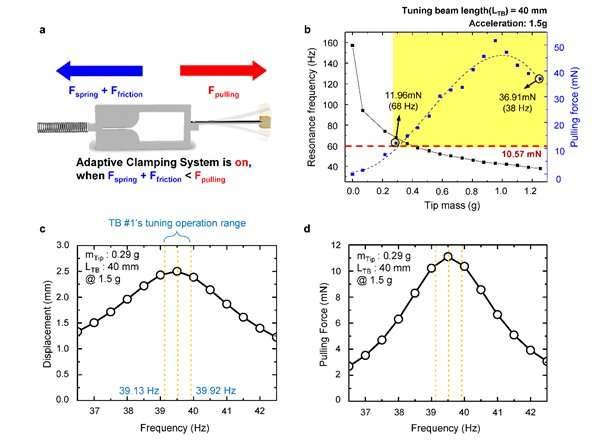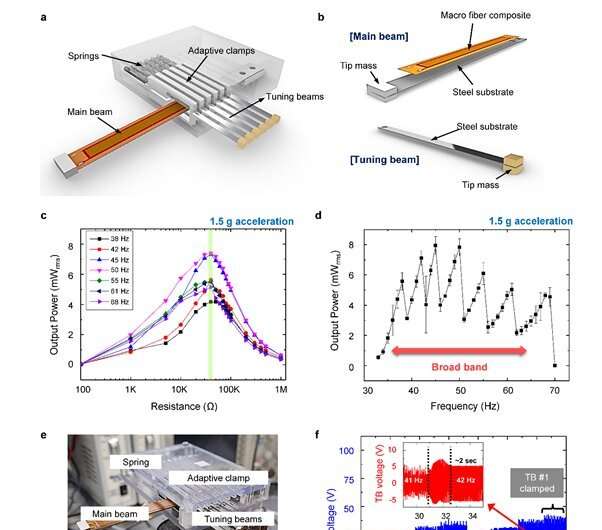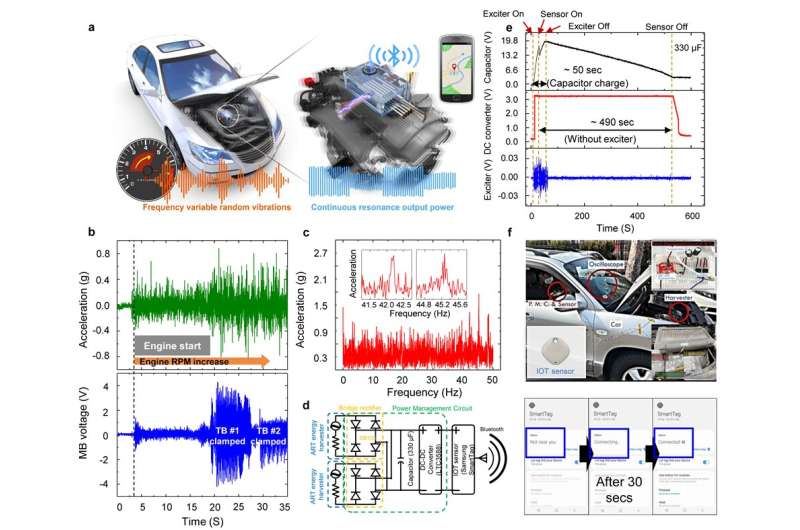Schematics for energy harvester structure and adaptive clamping system (above). Credit: Korea Institute of Science and Technology
The Internet of Things (IoT) is a network based on wireless sensor nodes that provide resources and information. For the long-lasting use of IoT devices, their batteries must be replaced, or a number of power line connections with complex wiring are required. Replacing batteries or connecting long power lines for numerous sensors installed in geographically inaccessible areas is time-consuming, dangerous, and costly.
Energy harvesting technology gathers wasted energy such as vibration, heat, light, and electromagnetic waves from everyday settings, such as automobiles, buildings, and home appliances, and converts it into electrical energy. Energy harvesters can generate sufficient electricity to run small electronic devices by harvesting ambient energy sources without an external power supply.
The Korea Institute of Science and Technology (KIST) announced that Dr. Hyun-Cheol Song's research team at the Electronic Materials Research Center developed an autonomous resonance tuning (ART) piezoelectric energy harvester that autonomously adjusts its resonance according to the surrounding environment. This energy harvester can tune its own resonance over a broad bandwidth of more than 30 Hz, and convert the absorbed vibration energy into electrical energy.
Graphs showing the characteristics of an ART energy harvester. Credit: Korea Institute of Science and Technology
The energy harvesting process that converts vibration into electrical energy inevitably causes a mechanical energy loss, which leads to low energy conversion efficiency. This problem can be solved by using the resonance phenomenon in which the vibration amplifies when the natural frequency of an object and the frequency of the vibration match.
However, while the natural frequency of the energy harvester is fixed, the various vibrations we experience in our everyday settings have different ranges of frequency. The natural frequency of the harvester therefore must be adjusted to the usage environment every time in order to induce resonance, making it difficult to put into practical use.
Accordingly, the KIST research team developed a specially designed energy harvester that can tune itself to the surrounding frequency without a separate electrical device. When the energy harvester senses the vibration of the surroundings, an adaptive clamping system (tuning system) attached to the harvester modulates its frequency to the same frequency as the external vibration, thus enabling resonance. As a result, it was possible to quickly achieve resonant frequency tuning within two seconds, continuously generating electricity in a broad bandwidth of more than 30Hz.
Diagrams showing the potential for practical use of an ART energy harvester that successfully drives a positioning device by utilizing the vibration energy of an automobile engine. Credit: Korea Institute of Science and Technology
For the real-world validation of the ART function, this energy harvester equipped with a tuning system was mounted on a vehicle. Unlike piezoelectric energy harvesters that have been introduced in preceding studies, it successfully drove a wireless positioning device without a battery in an environment where the vibration frequency continuously changed.
Dr. Song, who led this study, said, "This result suggests that energy harvesters using vibrations can be applied to our real life soon. It is expected to be applicable as an independent power source for wireless sensors, including the IOT, in the future."
More information: Dong‐Gyu Lee et al, Autonomous Resonance‐Tuning Mechanism for Environmental Adaptive Energy Harvesting, Advanced Science (2022). DOI: 10.1002/advs.202205179
Journal information: Advanced Science
Provided by National Research Council of Science & Technology


























